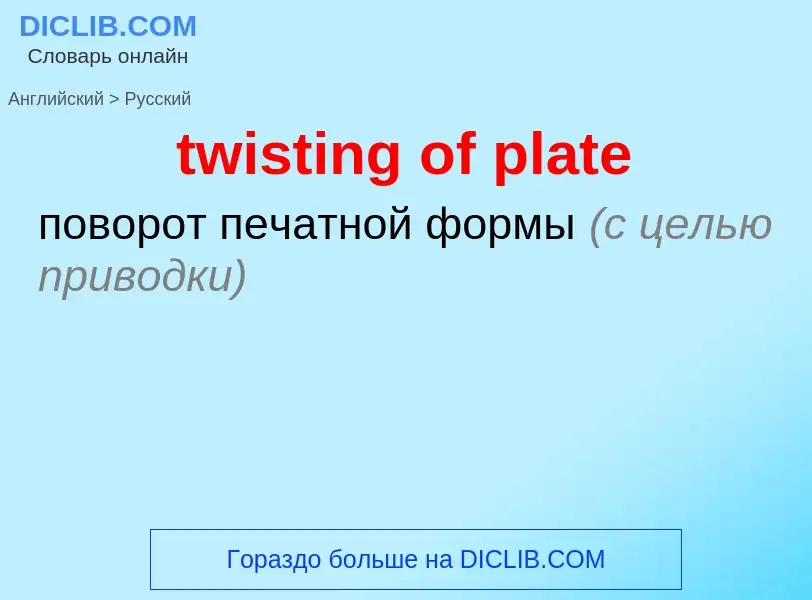Перевод и анализ слов искусственным интеллектом ChatGPT
На этой странице Вы можете получить подробный анализ слова или словосочетания, произведенный с помощью лучшей на сегодняшний день технологии искусственного интеллекта:
- как употребляется слово
- частота употребления
- используется оно чаще в устной или письменной речи
- варианты перевода слова
- примеры употребления (несколько фраз с переводом)
- этимология
twisting of plate - перевод на русский
общая лексика
микропланшет
общая лексика
титрационный микропланшет
общая лексика
рифлёный лист
общая лексика
каменный наружный подоконник
строительное дело
опорная подкладка под стойкой (напр. лесов)
лежень
нижний венец сруба
нефтегазовая промышленность
прогон (основания буровой установки)
существительное
строительное дело
лежень
Определение
.
Википедия
.jpg?width=120)
The Battle of the River Plate was fought in the South Atlantic on 13 December 1939 as the first naval battle of the Second World War. The Kriegsmarine heavy cruiser Admiral Graf Spee, commanded by Captain Hans Langsdorff, engaged a Royal Navy squadron, commanded by Commodore Henry Harwood, comprising the light cruisers HMS Ajax, HMS Achilles (on loan to the New Zealand Division) and the heavy cruiser HMS Exeter.
Graf Spee had sailed into the South Atlantic in August 1939, before the war began, and had begun commerce raiding after receiving appropriate authorisation on 26 September 1939. Harwood's squadron was one of several search groups sent in pursuit by the British Admiralty. They sighted Graf Spee off the estuary of the River Plate near the coasts of Argentina and Uruguay.
In the ensuing battle, Exeter was severely damaged and forced to retire; Ajax and Achilles suffered moderate damage. Damage to Graf Spee, although not extensive, was critical because her fuel system was crippled. Ajax and Achilles shadowed the German ship until she entered the port of Montevideo, the capital city of neutral Uruguay, to effect urgent repairs. Langsdorff was told that his stay could not be extended beyond 72 hours. Apparently believing that the British had gathered a superior force to await his departure, he ordered the ship to be scuttled. Three days later, Langsdorff killed himself.

.jpg?width=200)


![''Admiral Graf Spee'' in [[Montevideo]], with battle damage ''Admiral Graf Spee'' in [[Montevideo]], with battle damage](https://commons.wikimedia.org/wiki/Special:FilePath/Graf Spee Seetakt.jpg?width=200)

![rangefinder]] in Montevideo rangefinder]] in Montevideo](https://commons.wikimedia.org/wiki/Special:FilePath/Graf Spee telémetro 01.jpg?width=200)




![River Plate]] showing possible exit channels. River Plate]] showing possible exit channels.](https://commons.wikimedia.org/wiki/Special:FilePath/HMSO Graf Spee map of River Plate.jpg?width=200)
![HMS ''Achilles''; this painting by Frank Norton is part of the National Collection of War Art held by [[Archives New Zealand]] HMS ''Achilles''; this painting by Frank Norton is part of the National Collection of War Art held by [[Archives New Zealand]]](https://commons.wikimedia.org/wiki/Special:FilePath/HMS Achilles (HMNZS from 1941) (15333552416).jpg?width=200)




![''Admiral Graf Spee'']] ''Admiral Graf Spee'']]](https://commons.wikimedia.org/wiki/Special:FilePath/Panzerschiff Admiral Graf Spee in 1936.jpg?width=200)

![[[Liquid handling robot]] for 96 wells [[Liquid handling robot]] for 96 wells](https://commons.wikimedia.org/wiki/Special:FilePath/BioMek FX P200 96 liquid handling robot.jpg?width=200)


![Bronze [[muscle cuirass]], Italy, c. 350–300 BC Bronze [[muscle cuirass]], Italy, c. 350–300 BC](https://commons.wikimedia.org/wiki/Special:FilePath/Bronze cuirass BM GR1873.8-20.223.jpg?width=200)
![15th-century depiction of a [[melee]]. A breast plate is pierced by a sword 15th-century depiction of a [[melee]]. A breast plate is pierced by a sword](https://commons.wikimedia.org/wiki/Special:FilePath/Cod2823 fol150r.jpg?width=200)

![The ''Stechzeug'' of [[John the Constant]] (c. 1500) The ''Stechzeug'' of [[John the Constant]] (c. 1500)](https://commons.wikimedia.org/wiki/Special:FilePath/KHM Wien S XVI - Jousting armour of John the Constant, c. 1497-1505, front.jpg?width=200)

![Suit of armor of the Italian ''[[condottiero]]'' [[Roberto Sanseverino d'Aragona]] Suit of armor of the Italian ''[[condottiero]]'' [[Roberto Sanseverino d'Aragona]]](https://commons.wikimedia.org/wiki/Special:FilePath/KHM Wien A 3 - Armor of Roberto da Sanseverino (d. 1487).jpg?width=200)
![Painting of [[Charles V, Holy Roman Emperor]] by [[Juan Pantoja de la Cruz]] (c. 1605), after an original by [[Titian]], depicting an elaborate Renaissance-era suit of armour. Painting of [[Charles V, Holy Roman Emperor]] by [[Juan Pantoja de la Cruz]] (c. 1605), after an original by [[Titian]], depicting an elaborate Renaissance-era suit of armour.](https://commons.wikimedia.org/wiki/Special:FilePath/Emperor charles v.png?width=200)
![''Stechzeug''; note that the parts protecting the lower body and the legs were incorporated as part of the [[horse armour]] (not shown). ''Stechzeug''; note that the parts protecting the lower body and the legs were incorporated as part of the [[horse armour]] (not shown).](https://commons.wikimedia.org/wiki/Special:FilePath/Stechzeug of Maximilian I by Wendelin Boeheim.jpg?width=200)

![teams]] using wooden clubs (''Kolben'') to hit opponents' helmet crests. teams]] using wooden clubs (''Kolben'') to hit opponents' helmet crests.](https://commons.wikimedia.org/wiki/Special:FilePath/HJRK B 75, A 79 - Kolbenturnierhelm, 1480-85, and arms, 1486.jpg?width=200)

![[[Christian the Younger of Brunswick]] wearing [[cuirassier]] armour (1620) [[Christian the Younger of Brunswick]] wearing [[cuirassier]] armour (1620)](https://commons.wikimedia.org/wiki/Special:FilePath/Herzog Christian von Braunschweig-Lüneburg.jpg?width=200)
![Portrait of [[Charles III of Spain]] in a suit of armour (1761). Portrait of [[Charles III of Spain]] in a suit of armour (1761).](https://commons.wikimedia.org/wiki/Special:FilePath/Charles III of Spain.jpg?width=200)






![An unusual barn in [[Schoonebeek]], Netherlands with interrupted sills, the posts land directly on the padstone foundation An unusual barn in [[Schoonebeek]], Netherlands with interrupted sills, the posts land directly on the padstone foundation](https://commons.wikimedia.org/wiki/Special:FilePath/Zicht op doorgang van de schuur - Schoonebeek - 20411613 - RCE.jpg?width=200)
